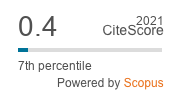Monitoring and risk assessment of pesticide residues in agricultural / horticultural commodities
Keywords:
Agricultural/horticultural commodities, pesticide, residues, risk assessmentAbstract
A study on monitoring and risk assessment of pesticide residues  in agricultural/horticultural commodities revealed that out of 33 samples detected with pesticides, 22 samples showed presence of multiple pesticides and most of these were not having label claim/approval for use in India by CIB&RC in that specific commodity. Chlorpyriphos was the most frequently detected insecticide followed by profenophos. None of the detected pesticides in commodities monitored during the study period resulted in an in take of >50 per cent of ARfD value which indicated that their consumption does not cause acute health risk. Among the different agricultural/horticultural  commodities like cardamom, cumin seed and curry leaf, the highest detected level of pesticides viz., lambda cyhalothrin and ethion in cardamom, profenophos in cumin seed and chlorpyriphos, profenophos and ethion in curry leaf exceeded 4 per cent of ADI value, which was considered as a margin indicating chronic health risk. Among the different pesticides studied, profenophos was present in levels of the ADI which represented a high level of chronic health risk to consumers. The results call for an investigation into the levels of pesticide residues in cardamom, cumin seed, curry leaf and for tighter regulation and regular monitoring by government and industry.
References
Adityachaudhury N., Banerjee H. and Kole R. K. (1997) An appraisal of pesticide use in Indian agriculture with special reference to their consumption in West Bengal. Science & Culture, 63: 223 - 228.
AICRP (PR) (2012) Annual Report of All India Co-ordinated Research Project on Pesticide Residues, Indian Council of Agricultural Research, New Delhi.
Claeys W. L., Schmit J. F., Bragard C., Maghuin-Rogister G., Pussemier L. and Schiffers B. (2011) K. Pallavi Nair et al. Exposure of several Belgian consumer groups to pesticide residues through fresh fruit and
vegetable consumption. Food Control, 22: 508-516.
Dalvie M. A. and London L. (2008). Risk assessment of pesticide residues in South African raw wheat. Crop Protection, 28: 864 - 869.
Mathew T. B., Nair K. P. and Beevi S. N. (2012) Pesticide residues – More thrust to food or environment. In: Proceedings of 22nd Swadeshi Science Congress on Ecosystem Services through Plantation Crops; 6 - 8 November 2012; CPCRI, Kasargod. Swadeshi Science Movement, Kerala, Shastra Bhavan, Kochi, pp 32-34.
Report of Government of Kerala, Department of Agriculture (2011) Substitutes for pesticides banned by Govt. of Kerala vide G.O. (MS) No. 116/2011/ Agri. dated 07-05-2011.
Usha S. (2007) Pesticide use in the high ranges and its implications. In Gleanings In Cardamom Eds. Joseph Raj Kumar A., Backiyarani S. and Shivakumar G., KAU Publication, Thrissur, pp.82.
Uygun U., Koksel H. and Atli A. (2005) Residue levels of malathion and its metabolites and fenitrothion in post harvest treated wheat during storage, milling and baking. Food Chemistry, 92: 643 - 647.
WHO (1997). Guidelines for Predicting Dietary Intake of Pesticide Residues. Global Environment Monitoring System - Food Contamination, Monitoring and Assessment Programme (GEMS/ Foods) (Geneva, World Health Organization, Programme of Food Safety and Food Aid).
Zhang C., Xin-ming Z., Zi-huahe T., Dan-jun and Xian-jin L. (2010) Degradation of chlorpyrifos and fipronil in rice from farm to fork and risk assessment. Agricultural Sciences in China, 9: 754 - 763.


